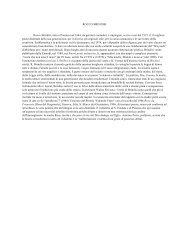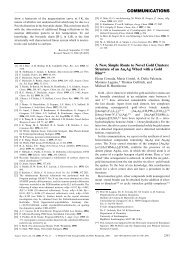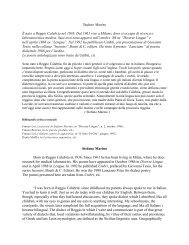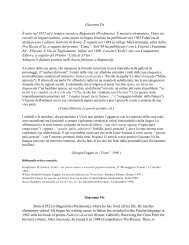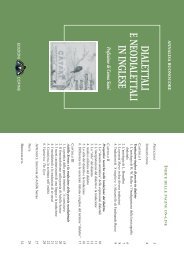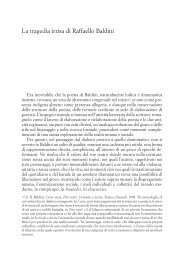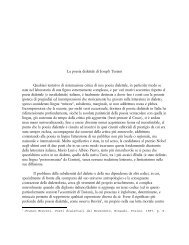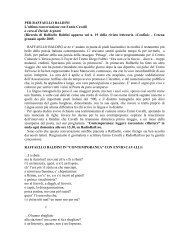Journal of Italian Translation
Journal of Italian Translation
Journal of Italian Translation
Create successful ePaper yourself
Turn your PDF publications into a flip-book with our unique Google optimized e-Paper software.
Lina Insana/Primo Levi<br />
sapienza, di raccontare non solo il nostro destino, ma anche quello degli<br />
altri, dei sommersi, appunto...Parliamo noi in loro vece, per delega” (65).<br />
Implicit in this model is the fact that the weight <strong>of</strong> responsibility must be<br />
distributed among speakers and listeners alike at many different levels, as<br />
the “salvati” must become witnesses to the atrocities committed against the<br />
“sommersi” and the survivor’s listener-reader must, in turn, bear witness to<br />
that which is recounted to him by the survivor. It is not enough merely to tell,<br />
but the reader-listener after the fact must also be a willing interlocutor and<br />
witness, mirroring and repeating the narrative testimonial act <strong>of</strong> the survivor<br />
to create an infinite chain <strong>of</strong> witnessing and telling, listening and witnessing.<br />
Similarly, for Coleridge there is a tendency to “dissolv[e] the distinction<br />
between the roles <strong>of</strong> speaker and audience: both here are equally in<br />
thrall to the tale” (Eilenberg 287-88). For both the Holocaust survivor and the<br />
protagonist <strong>of</strong> the “Rime,” each link in the transmission <strong>of</strong> the tale is simultaneously<br />
narrator and narratee, yet another example <strong>of</strong> the manner in which<br />
the representation en abyme <strong>of</strong> the transmissive act shines a particularly<br />
bright meta-narrative light on the process <strong>of</strong> witnessing. Referring to the<br />
Coleridge poem, Eilenberg identifies this phenomenon as a thematic “doubling”<br />
<strong>of</strong> the protagonist in that “each person who hears the story becomes,<br />
like the Mariner, the teller <strong>of</strong> that story” (277). For Eilenberg, these textual<br />
doubles include the sixteenth-century “mistral who narrates the poem that<br />
the antiquarian would gloss” (291), as well as the Hermit and Wedding<br />
Guest who are the Mariner’s most immediate interlocutors. Upon close inspection,<br />
it becomes clear that Levi’s own poem shares Coleridge’s predilection<br />
for textual doubles, though not as explicit as those present in the “Rime.”<br />
Ultimately, the poet and his survivor persona are at once elements and propagators<br />
<strong>of</strong> the poem’s doubling mechanism: a poet who quotes Coleridge’s<br />
original English text, who knows but sets aside a good-faith <strong>Italian</strong> translation<br />
<strong>of</strong> Coleridge (Beppe Fenoglio’s), who puts forth his own translation <strong>of</strong><br />
Coleridge; and a survivor, who, in his vehement denial <strong>of</strong> any wrongdoing<br />
against the “gente sommersa,” implicitly cites the charges <strong>of</strong> his accusers.<br />
Even the final line <strong>of</strong> the poem constitutes another layer <strong>of</strong> this game <strong>of</strong><br />
doubling through citation, as the survivor translates Dante (“e mangia e bee<br />
e dorme e veste panni” [Inferno 33.141]), once again making revealing changes<br />
<strong>of</strong> person and perspective (“E mangio e bevo e dormo e vesto panni” [v. 20]),<br />
to invoke the double <strong>of</strong> the traitor Branca D’Oria. 9<br />
But in keeping with poetry’s role as the space in which this author<br />
works through his more conflicted responses to survivor hood, Levi’s unfaithful<br />
translation <strong>of</strong> the fourth verse also serves to undermine this very<br />
narrative model whereby interlocutors, and therefore witnesses, are created<br />
within the textual space <strong>of</strong> testimony. While Coleridge’s main verb is decidedly<br />
indicative (“And till my ghastly tale is told”), Levi’s version is constructed<br />
on the first part <strong>of</strong> a hypothetical phrase, presenting the possibility<br />
<strong>of</strong> an audience in the subjunctive mode—possible, but not certain: “E se non<br />
trova chi lo ascolti.” Levi’s translation <strong>of</strong> Coleridge, then, prompts us to ques-<br />
27



